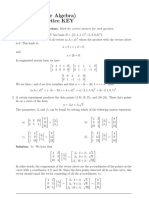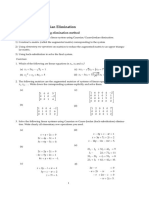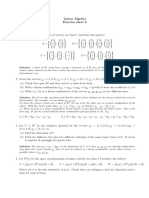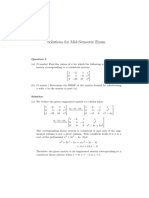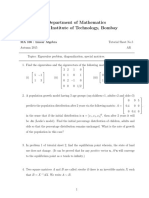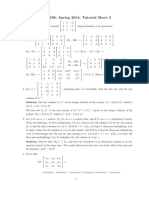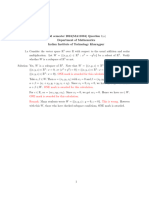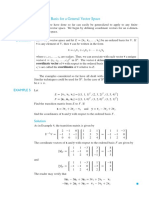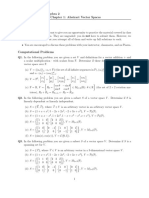MATH 304
Linear Algebra
Lecture 13:
Review for Test 1.
Topics for Test 1
Part I: Elementary linear algebra (Leon 1.11.5,
2.12.2)
Systems of linear equations: elementary
operations, Gaussian elimination, back substitution.
Matrix of coecients and augmented matrix.
Elementary row operations, row echelon form and
reduced row echelon form.
Matrix algebra. Inverse matrix.
Determinants: explicit formulas for 22 and
33 matrices, row and column expansions,
elementary row and column operations.
Topics for Test 1
Part II: Abstract linear algebra (Leon 3.13.4, 3.6)
Vector spaces (vectors, matrices, polynomials,
functional spaces).
Subspaces. Nullspace, column space, and row
space of a matrix.
Span, spanning set. Linear independence.
Basis and dimension.
Rank and nullity of a matrix.
Sample problems for Test 1
Problem 1 (15 pts.) Find a quadratic polynomial p(x)
such that p(1) = 1, p(2) = 3, and p(3) = 7.
Problem 2 (25 pts.) Let A =
_
_
_
_
1 2 4 1
2 3 2 0
2 0 1 1
2 0 0 1
_
_
_
_
.
(i) Evaluate the determinant of the matrix A.
(ii) Find the inverse matrix A
1
.
Problem 3 (20 pts.) Determine which of the following subsets
of R
3
are subspaces. Briey explain.
(i) The set S
1
of vectors (x, y, z) R
3
such that xyz = 0.
(ii) The set S
2
of vectors (x, y, z) R
3
such that x + y + z = 0.
(iii) The set S
3
of vectors (x, y, z) R
3
such that y
2
+ z
2
= 0.
(iv) The set S
4
of vectors (x, y, z) R
3
such that y
2
z
2
= 0.
Problem 4 (30 pts.) Let B =
_
_
_
_
0 1 4 1
1 1 2 1
3 0 1 0
2 1 0 1
_
_
_
_
.
(i) Find the rank and the nullity of the matrix B.
(ii) Find a basis for the row space of B, then extend this basis to a
basis for R
4
.
(iii) Find a basis for the nullspace of B.
Bonus Problem 5 (15 pts.) Show that the functions
f
1
(x) = x, f
2
(x) = xe
x
, and f
3
(x) = e
x
are linearly
independent in the vector space C
(R).
Bonus Problem 6 (15 pts.) Let V be a nite-dimensional
vector space and V
0
be a proper subspace of V (where proper
means that V
0
= V). Prove that dimV
0
< dimV.
Problem 1. Find a quadratic polynomial p(x) such that
p(1) = 1, p(2) = 3, and p(3) = 7.
Let p(x) = ax
2
+ bx + c. Then p(1) = a + b + c,
p(2) = 4a + 2b + c, and p(3) = 9a + 3b + c.
The coecients a, b, and c have to be chosen so that
_
_
_
a + b + c = 1,
4a + 2b + c = 3,
9a + 3b + c = 7.
We solve this system of linear equations using elementary
operations:
_
_
_
a + b + c = 1
4a + 2b + c = 3
9a + 3b + c = 7
_
_
_
a + b + c = 1
3a + b = 2
9a + 3b + c = 7
_
_
_
a + b + c = 1
3a + b = 2
9a + 3b + c = 7
_
_
_
a + b + c = 1
3a + b = 2
8a + 2b = 6
_
_
_
a + b + c = 1
3a + b = 2
4a + b = 3
_
_
_
a + b + c = 1
3a + b = 2
a = 1
_
_
_
a + b + c = 1
b = 1
a = 1
_
_
_
c = 1
b = 1
a = 1
Thus the desired polynomial is p(x) = x
2
x + 1.
Problem 2. Let A =
_
_
_
_
1 2 4 1
2 3 2 0
2 0 1 1
2 0 0 1
_
_
_
_
.
(i) Evaluate the determinant of the matrix A.
Subtract the 4th row of A from the 3rd row:
1 2 4 1
2 3 2 0
2 0 1 1
2 0 0 1
1 2 4 1
2 3 2 0
0 0 1 0
2 0 0 1
.
Expand the determinant by the 3rd row:
1 2 4 1
2 3 2 0
0 0 1 0
2 0 0 1
= (1)
1 2 1
2 3 0
2 0 1
.
Expand the determinant by the 3rd column:
(1)
1 2 1
2 3 0
2 0 1
= (1)
_
2 3
2 0
1 2
2 3
_
= 1.
Problem 2. Let A =
_
_
_
_
1 2 4 1
2 3 2 0
2 0 1 1
2 0 0 1
_
_
_
_
.
(ii) Find the inverse matrix A
1
.
First we merge the matrix A with the identity matrix into one
4 8 matrix
(A| I ) =
_
_
_
_
1 2 4 1 1 0 0 0
2 3 2 0 0 1 0 0
2 0 1 1 0 0 1 0
2 0 0 1 0 0 0 1
_
_
_
_
.
Then we apply elementary row operations to this matrix until
the left part becomes the identity matrix.
Subtract 2 times the 1st row from the 2nd row:
_
_
_
_
1 2 4 1 1 0 0 0
0 7 6 2 2 1 0 0
2 0 1 1 0 0 1 0
2 0 0 1 0 0 0 1
_
_
_
_
Subtract 2 times the 1st row from the 3rd row:
_
_
_
_
1 2 4 1 1 0 0 0
0 7 6 2 2 1 0 0
0 4 9 1 2 0 1 0
2 0 0 1 0 0 0 1
_
_
_
_
Subtract 2 times the 1st row from the 4th row:
_
_
_
_
1 2 4 1 1 0 0 0
0 7 6 2 2 1 0 0
0 4 9 1 2 0 1 0
0 4 8 1 2 0 0 1
_
_
_
_
Subtract 2 times the 4th row from the 2nd row:
_
_
_
_
1 2 4 1 1 0 0 0
0 1 10 0 2 1 0 2
0 4 9 1 2 0 1 0
0 4 8 1 2 0 0 1
_
_
_
_
Subtract the 4th row from the 3rd row:
_
_
_
_
1 2 4 1 1 0 0 0
0 1 10 0 2 1 0 2
0 0 1 0 0 0 1 1
0 4 8 1 2 0 0 1
_
_
_
_
Add 4 times the 2nd row to the 4th row:
_
_
_
_
1 2 4 1 1 0 0 0
0 1 10 0 2 1 0 2
0 0 1 0 0 0 1 1
0 0 32 1 6 4 0 7
_
_
_
_
Add 32 times the 3rd row to the 4th row:
_
_
_
_
1 2 4 1 1 0 0 0
0 1 10 0 2 1 0 2
0 0 1 0 0 0 1 1
0 0 0 1 6 4 32 39
_
_
_
_
Add 10 times the 3rd row to the 2nd row:
_
_
_
_
1 2 4 1 1 0 0 0
0 1 0 0 2 1 10 12
0 0 1 0 0 0 1 1
0 0 0 1 6 4 32 39
_
_
_
_
Add the 4th row to the 1st row:
_
_
_
_
1 2 4 0 7 4 32 39
0 1 0 0 2 1 10 12
0 0 1 0 0 0 1 1
0 0 0 1 6 4 32 39
_
_
_
_
Add 4 times the 3rd row to the 1st row:
_
_
_
_
1 2 0 0 7 4 36 43
0 1 0 0 2 1 10 12
0 0 1 0 0 0 1 1
0 0 0 1 6 4 32 39
_
_
_
_
Subtract 2 times the 2nd row from the 1st row:
_
_
_
_
1 0 0 0 3 2 16 19
0 1 0 0 2 1 10 12
0 0 1 0 0 0 1 1
0 0 0 1 6 4 32 39
_
_
_
_
Multiply the 2nd, the 3rd, and the 4th rows by 1:
_
_
_
_
1 0 0 0 3 2 16 19
0 1 0 0 2 1 10 12
0 0 1 0 0 0 1 1
0 0 0 1 6 4 32 39
_
_
_
_
_
_
_
_
1 0 0 0 3 2 16 19
0 1 0 0 2 1 10 12
0 0 1 0 0 0 1 1
0 0 0 1 6 4 32 39
_
_
_
_
= (I | A
1
)
Finally the left part of our 4 8 matrix is transformed into the
identity matrix. Therefore the current right part is the inverse
matrix of A. Thus
A
1
=
_
_
_
_
1 2 4 1
2 3 2 0
2 0 1 1
2 0 0 1
_
_
_
_
1
=
_
_
_
_
3 2 16 19
2 1 10 12
0 0 1 1
6 4 32 39
_
_
_
_
.
Problem 2. Let A =
_
_
_
_
1 2 4 1
2 3 2 0
2 0 1 1
2 0 0 1
_
_
_
_
.
(i) Evaluate the determinant of the matrix A.
Alternative solution: We have transformed A into the identity
matrix using elementary row operations. These included no
row exchanges and three row multiplications, each time by 1.
It follows that det I = (1)
3
det A.
= det A = det I = 1.
Problem 3. Determine which of the following
subsets of R
3
are subspaces. Briey explain.
A subset of R
3
is a subspace if it is closed under addition and
scalar multiplication. Besides, the subset must not be empty.
(i) The set S
1
of vectors (x, y, z) R
3
such that
xyz = 0.
(0, 0, 0) S
1
= S
1
is not empty.
xyz = 0 = (rx)(ry)(rz) = r
3
xyz = 0.
That is, v = (x, y, z) S
1
= r v = (rx, ry, rz) S
1
.
Hence S
1
is closed under scalar multiplication.
However S
1
is not closed under addition.
Counterexample: (1, 1, 0) + (0, 0, 1) = (1, 1, 1).
Problem 3. Determine which of the following
subsets of R
3
are subspaces. Briey explain.
A subset of R
3
is a subspace if it is closed under addition and
scalar multiplication. Besides, the subset must not be empty.
(ii) The set S
2
of vectors (x, y, z) R
3
such that
x + y + z = 0.
(0, 0, 0) S
2
= S
2
is not empty.
x + y + z = 0 = rx + ry + rz = r (x + y + z) = 0.
Hence S
2
is closed under scalar multiplication.
x + y + z = x
+ y
+ z
= 0 =
(x +x
) +(y +y
) +(z +z
) = (x +y +z) +(x
+y
+z
) = 0.
That is, v = (x, y, z), v
= (x
, y
, z
) S
2
= v + v
= (x + x
, y + y
, z + z
) S
2
.
Hence S
2
is closed under addition.
(iii) The set S
3
of vectors (x, y, z) R
3
such that
y
2
+ z
2
= 0.
y
2
+ z
2
= 0 y = z = 0.
S
3
is a nonempty set closed under addition and scalar
multiplication.
(iv) The set S
4
of vectors (x, y, z) R
3
such that
y
2
z
2
= 0.
S
4
is a nonempty set closed under scalar multiplication.
However S
4
is not closed under addition.
Counterexample: (0, 1, 1) + (0, 1, 1) = (0, 2, 0).
Problem 4. Let B =
_
_
_
_
0 1 4 1
1 1 2 1
3 0 1 0
2 1 0 1
_
_
_
_
.
(i) Find the rank and the nullity of the matrix B.
The rank (= dimension of the row space) and the nullity
(= dimension of the nullspace) of a matrix are preserved under
elementary row operations. We apply such operations to
convert the matrix B into row echelon form.
Interchange the 1st row with the 2nd row:
_
_
_
_
1 1 2 1
0 1 4 1
3 0 1 0
2 1 0 1
_
_
_
_
Add 3 times the 1st row to the 3rd row, then subtract 2 times
the 1st row from the 4th row:
_
_
_
_
1 1 2 1
0 1 4 1
0 3 5 3
2 1 0 1
_
_
_
_
_
_
_
_
1 1 2 1
0 1 4 1
0 3 5 3
0 3 4 3
_
_
_
_
Multiply the 2nd row by 1:
_
_
_
_
1 1 2 1
0 1 4 1
0 3 5 3
0 3 4 3
_
_
_
_
Add the 4th row to the 3rd row:
_
_
_
_
1 1 2 1
0 1 4 1
0 0 1 0
0 3 4 3
_
_
_
_
Add 3 times the 2nd row to the 4th row:
_
_
_
_
1 1 2 1
0 1 4 1
0 0 1 0
0 0 16 0
_
_
_
_
Add 16 times the 3rd row to the 4th row:
_
_
_
_
1 1 2 1
0 1 4 1
0 0 1 0
0 0 0 0
_
_
_
_
Now that the matrix is in row echelon form, its rank equals the
number of nonzero rows, which is 3. Since
(rank of B) + (nullity of B) = (the number of columns of B) = 4,
it follows that the nullity of B equals 1.
Problem 4. Let B =
_
_
_
_
0 1 4 1
1 1 2 1
3 0 1 0
2 1 0 1
_
_
_
_
.
(ii) Find a basis for the row space of B, then extend this basis
to a basis for R
4
.
The row space of a matrix is invariant under elementary row
operations. Therefore the row space of the matrix B is the
same as the row space of its row echelon form:
_
_
_
_
0 1 4 1
1 1 2 1
3 0 1 0
2 1 0 1
_
_
_
_
_
_
_
_
1 1 2 1
0 1 4 1
0 0 1 0
0 0 0 0
_
_
_
_
.
The nonzero rows of the latter matrix are linearly independent
so that they form a basis for its row space:
v
1
= (1, 1, 2, 1), v
2
= (0, 1, 4, 1), v
3
= (0, 0, 1, 0).
To extend the basis v
1
, v
2
, v
3
to a basis for R
4
, we need a
vector v
4
R
4
that is not a linear combination of v
1
, v
2
, v
3
.
It is known that at least one of the vectors e
1
= (1, 0, 0, 0),
e
2
= (0, 1, 0, 0), e
3
= (0, 0, 1, 0), and e
4
= (0, 0, 0, 1) can be
chosen as v
4
.
In particular, the vectors v
1
, v
2
, v
3
, e
4
form a basis for R
4
.
This follows from the fact that the 4 4 matrix whose rows
are these vectors is not singular:
1 1 2 1
0 1 4 1
0 0 1 0
0 0 0 1
= 1 = 0.
Problem 4. Let B =
_
_
_
_
0 1 4 1
1 1 2 1
3 0 1 0
2 1 0 1
_
_
_
_
.
(iii) Find a basis for the nullspace of B.
The nullspace of B is the solution set of the system of linear
homogeneous equations with B as the coecient matrix. To
solve the system, we convert B to reduced row echelon form:
_
_
_
_
1 1 2 1
0 1 4 1
0 0 1 0
0 0 0 0
_
_
_
_
_
_
_
_
1 0 0 0
0 1 0 1
0 0 1 0
0 0 0 0
_
_
_
_
= x
1
= x
2
x
4
= x
3
= 0
General solution: (x
1
, x
2
, x
3
, x
4
) = (0, t, 0, t) = t(0, 1, 0, 1).
Thus the vector (0, 1, 0, 1) forms a basis for the nullspace of B.
Bonus Problem 5. Show that the functions f
1
(x) = x,
f
2
(x) = xe
x
, and f
3
(x) = e
x
are linearly independent in the
vector space C
(R).
The functions f
1
, f
2
, f
3
are linearly independent whenever the
Wronskian W[f
1
, f
2
, f
3
] is not identically zero.
W[f
1
, f
2
, f
3
](x) =
f
1
(x) f
2
(x) f
3
(x)
f
1
(x) f
2
(x) f
3
(x)
f
1
(x) f
2
(x) f
3
(x)
x xe
x
e
x
1 e
x
+xe
x
e
x
0 2e
x
+xe
x
e
x
= e
x
x xe
x
1
1 e
x
+xe
x
1
0 2e
x
+xe
x
1
x x 1
1 1+x 1
0 2+x 1
= x
1+x 1
2+x 1
x 1
2+x 1
= x(2x +3) +2 = 2x
2
+3x +2.
The polynomial 2x
2
+ 3x + 2 is never zero.
Bonus Problem 5. Show that the functions f
1
(x) = x,
f
2
(x) = xe
x
, and f
3
(x) = e
x
are linearly independent in the
vector space C
(R).
Alternative solution: Suppose that af
1
(x)+bf
2
(x)+cf
3
(x) = 0
for all x R, where a, b, c are constants. We have to show
that a = b = c = 0.
Let us dierentiate this identity:
ax + bxe
x
+ ce
x
= 0,
a + be
x
+ bxe
x
ce
x
= 0,
2be
x
+ bxe
x
+ ce
x
= 0,
3be
x
+ bxe
x
ce
x
= 0,
4be
x
+ bxe
x
+ ce
x
= 0.
(the 5th identity)(the 3rd identity): 2be
x
= 0 = b = 0.
Substitute b = 0 in the 3rd identity: ce
x
= 0 = c = 0.
Substitute b = c = 0 in the 2nd identity: a = 0.
Bonus Problem 5. Show that the functions f
1
(x) = x,
f
2
(x) = xe
x
, and f
3
(x) = e
x
are linearly independent in the
vector space C
(R).
Alternative solution: Suppose that ax + bxe
x
+ ce
x
= 0 for
all x R, where a, b, c are constants. We have to show that
a = b = c = 0.
For any x = 0 divide both sides of the identity by xe
x
:
ae
x
+ b + cx
1
e
2x
= 0.
The left-hand side approaches b as x +. = b = 0
Now ax + ce
x
= 0 for all x R. For any x = 0 divide
both sides of the identity by x:
a + cx
1
e
x
= 0.
The left-hand side approaches a as x +. = a = 0
Now ce
x
= 0 = c = 0.
Bonus Problem 6. Let V be a nite-dimensional vector
space and V
0
be a proper subspace of V (where proper means
that V
0
= V). Prove that dimV
0
< dimV.
Any vector space has a basis. Let v
1
, v
2
, . . . , v
k
be a basis
for V
0
.
Vectors v
1
, v
2
, . . . , v
k
are linearly independent in V since they
are linearly independent in V
0
. Therefore we can extend this
collection of vectors to a basis for V by adding some vectors
w
1
, . . . , w
m
. As V
0
= V, we do need to add some vectors,
i.e., m 1.
Thus dimV
0
= k and dimV = k + m > k.






